An erratic journey to the moon in Space Engineers
Samuel and Phil build a spaceship.
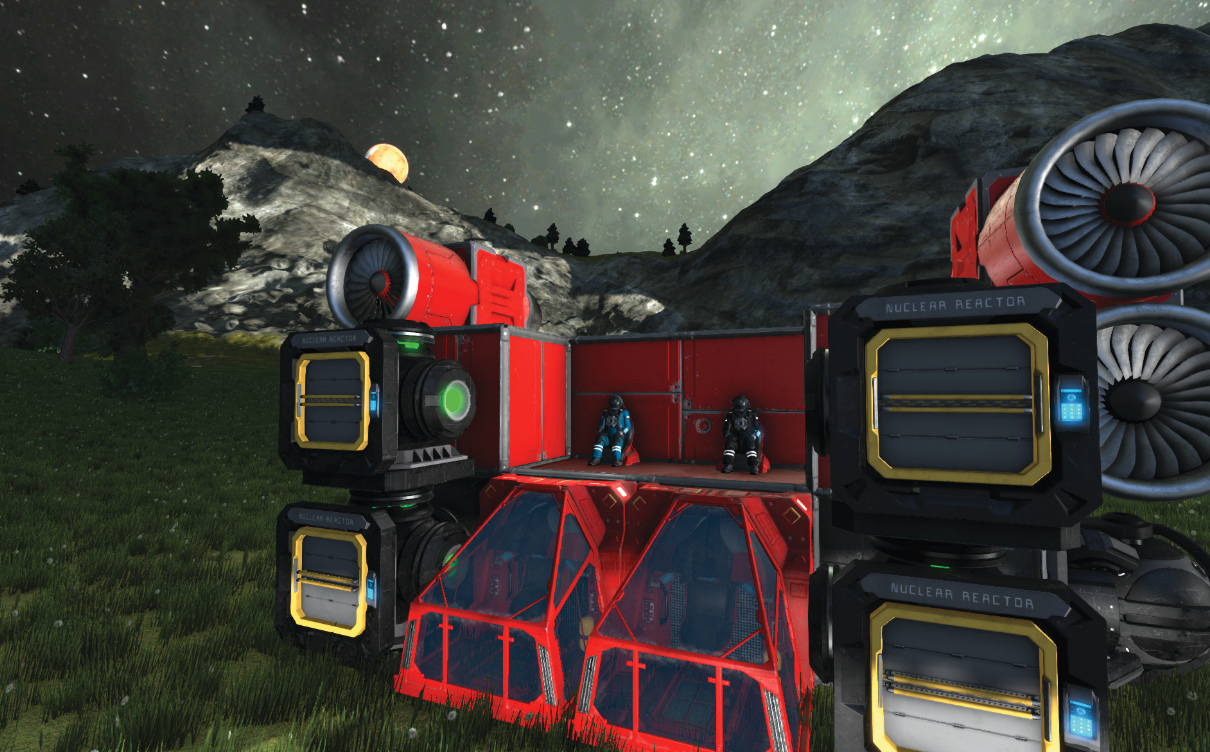
This article was originally published in PC Gamer issue 302. For more quality articles about all things PC gaming, you can subscribe now in the UK and the US.
In a Steam sale long ago, on a whim, Samuel picked up the sandbox and construction game Space Engineers. For this feature, he and Phil teamed up to build a spaceship in it, to leave Earth in that spaceship and to fly it to the Moon—all without knowing how the game actually worked, or paying any attention to its tutorials.
Finding each other


Buys games on a whim then makes his team do features on them.
Phil: I launch a creative mode server, spawning in a base on Earth. Samuel joins, and... Sam, where are you?
Samuel: I’m 66km away, Phil, having spawned in the Earth’s atmosphere, and I’m in a landing craft which means I’m essentially falling with style rather than actually controlling where I’m going. You can’t just spawn next to a co-op partner in this game straight away, which is a bit annoying. But damn it, I want us to build a spaceship together.
Phil: I create a new faction, the PCG Space Boys, in the hope of getting a permanent waypoint marker for Samuel’s location. That doesn’t work. Instead, because I had to leave my original faction, my entire base becomes hostile to me. I flee to a nearby hill, set a manual GPS marker and wait. Then I build a sign, because what else are you going to do when you’re stranded alone on a hostile planet?
Samuel: Phil fiddles around until he finds out how to set a waypoint, and now I have to get to him. This means fitting atmospheric thrusters to my landing craft, which makes it just about fast enough to leapfrog across the world to where Phil waits for me. It’s fast enough to get me there, but not so fast that I can actually take off from the ground for more than ten seconds. When I reach my destination, I see a HELP sign very cleverly made out of spaceship parts. “I’m on top of the E,” Phil tells me. We meet at last.
Phil: We need a flat location to construct our ship, but we’d be building around machine gun fire if we did it back at my base. Instead we head to the valley below, and hope the ground is even enough to facilitate the construction of a spacefaring vessel. I bet NASA never had to deal with this shit. Another problem is that I don’t know how to play this game. Even building that HELP sign took longer than I’d care to admit. I plop down a cockpit, but sideways, embedding it in the ground. This won’t do at all.
The biggest gaming news, reviews and hardware deals
Keep up to date with the most important stories and the best deals, as picked by the PC Gamer team.
Building a spaceship
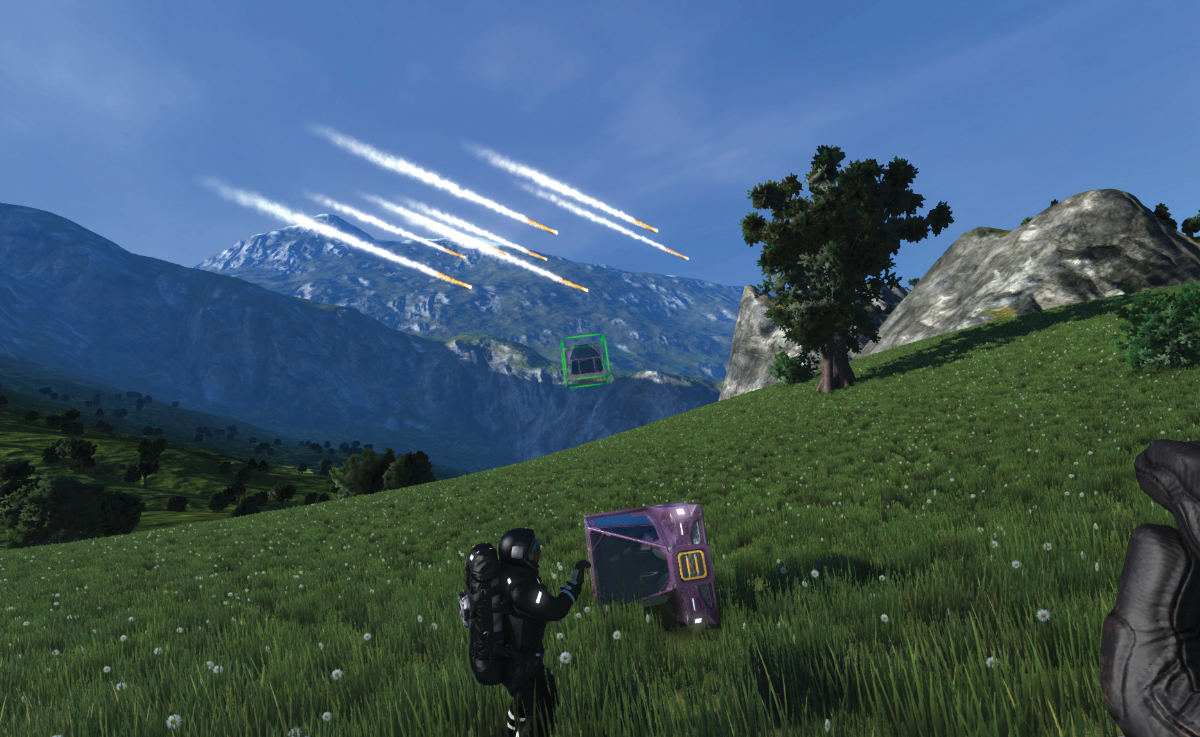
Samuel: This is a PC Gamer ship, so damn it, we will build it out of red and black bricks. Phil’s cockpit is purple—and sideways. I start by placing a new cockpit and attach it to a block, so that the vague shape of a spaceship begins to take form. We agree that the ship needs two cockpits, because there are two of us, so we stick those together. I add two reactors, so the ship can actually take off, and then we start fitting thrusters onto it, which should—in theory—allow us to touch the stars. I also attach a couple of gyroscopes. I don’t know what they do, but they should probably be there, because science possibly.
Phil: While Samuel builds an impressive looking frame, I muck around in the background figuring out how things work. I place a couple of massive floodlights near our build to improve nighttime visibility—both to learn how electrical systems function, and because it sounds like the sort of thing a helpful, knowledgeable co-op partner would do. Samuel is fiddling with power sources and gyroscopes—all things I don’t understand—so to further mask my incompetence, I jump in and add thrusters. Lots and lots of thrusters.
Samuel: To be honest, on the quick play of Space Engineers I had before this, I basically just taped loads of thrusters to a cockpit and hoped for the best. So really, Phil and I are just as incompetent as each other. Who better to reach the Moon than us?
Phil: The ship isn’t very aerodynamic-looking, but the sheer number of thrusters should count for something. As a final touch—because I appreciate the majesty of space travel—I strap a couple of seats to the top of the ship, creating an ad-hoc viewing platform. Again, it’s not scientifically advisable, but we seem to be invulnerable in creative mode, so what’s the harm?
Samuel: These seats, I should point out, are not in a contained environment, so humans probably shouldn’t sit on them on a moving spaceship. I sit down anyway and prepare for lift-off.
To the moon
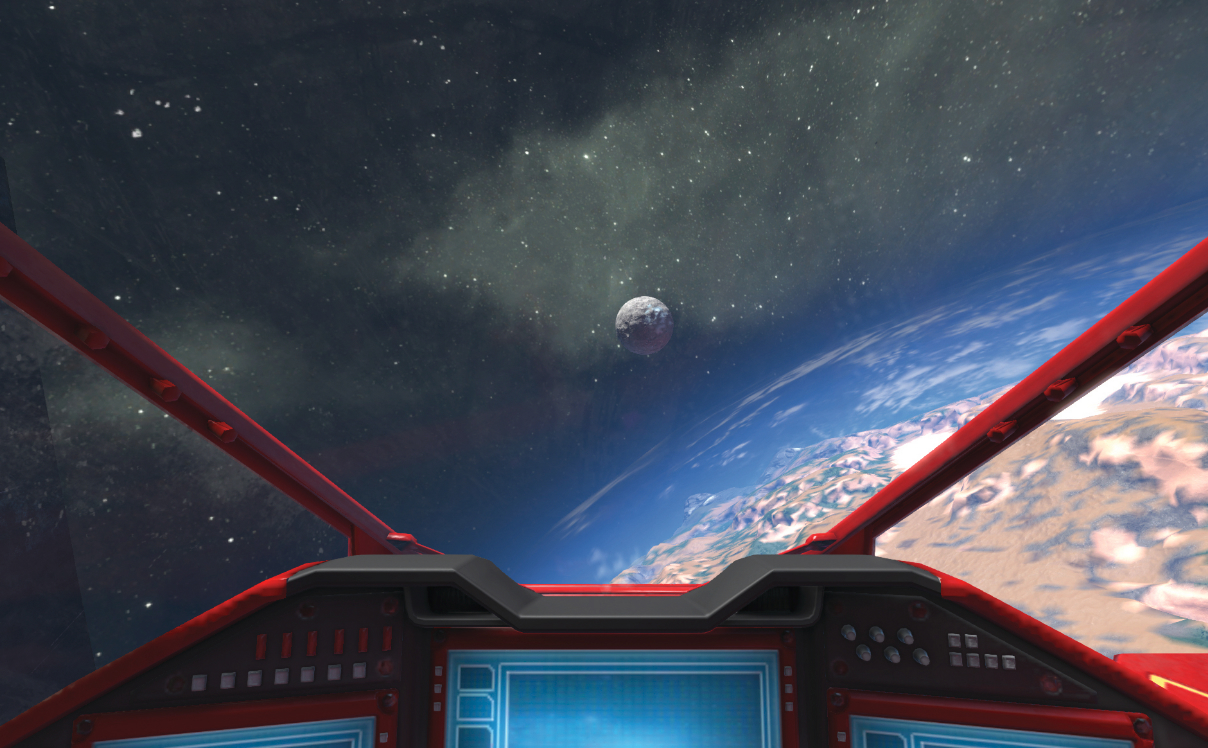

Veteran of Kerbal Space Program, so knows about pretend space.
Phil: The view from inside the cockpit seems weird, making it hard to get my bearings. I press W and nothing much happens. I press the spacebar, and we start to build some momentum. We reach an impressive height, but I’m navigating entirely with the altimeter because I can’t tell what’s happening outside my window. It almost looks as if the atmospheric engines are at the bottom of my viewscreen. But that would mean I was upside down, and perpendicular to the bottom of the craft. Surely not.
Samuel: Hmm, what design error could possibly have caused that? I’m not sure. It feels oddly rewarding to see our piece-of-crap spaceship break out of the Earth’s atmosphere, though, and to see the world behind us vanish. Hang on a minute. When I started the design of the ship, did I accidentally attach the cockpits so they were looking upwards instead of forwards? Is that what I did, Phil?
Phil: I think that’s what you did, Sam. That would explain why pressing the up key makes us go forwards. On the plus side, we’re 10,000 metres up in the sky—that’s basically space. On the down side, getting to the Moon would mean doing the entire journey looking 90 degrees away from the Moon. I don’t think I’m that good of a pilot.
Samuel: How did I not notice this during the test flight? I did wonder why you kept saying “the ship’s upside down!” when from my perspective in the cockpit it was clearly the right side up. You can’t muck about when it comes to the Moon. I decide to get off my chair in the middle of space and sort it out. It turns out this is a terrible idea—I float away uncontrollably.
Phil: I know it seems like I’m leaving you stranded in space, Sam, but this ship doesn’t have brakes. I turn off the engine and we both plummet back to Earth—me in the ship, Samuel in nothing but the astronaut suit he spawned in. Fortunately, we land only a couple of kilometres apart. We fix up the cockpit so that it points in the right direction, and, now that I can see where I’m going, we make it easily back into space. The Moon is quite some distance away, though, and even after we stop on an asteroid to add yet more thrusters, reaching it looks like it could take some time. I press W and wait.
Samuel: I have to go to a boring real-life meeting, which lasts for ten minutes. The Moon seems miles away when I leave. The second I come back, Phil is about to collide with the thing. We did it! We went to the Moon! What happened while I was away, Phil?Phil: I alt-tabbed out to do some work. Space travel is pretty majestic.
Beyond the infinite (Mars)
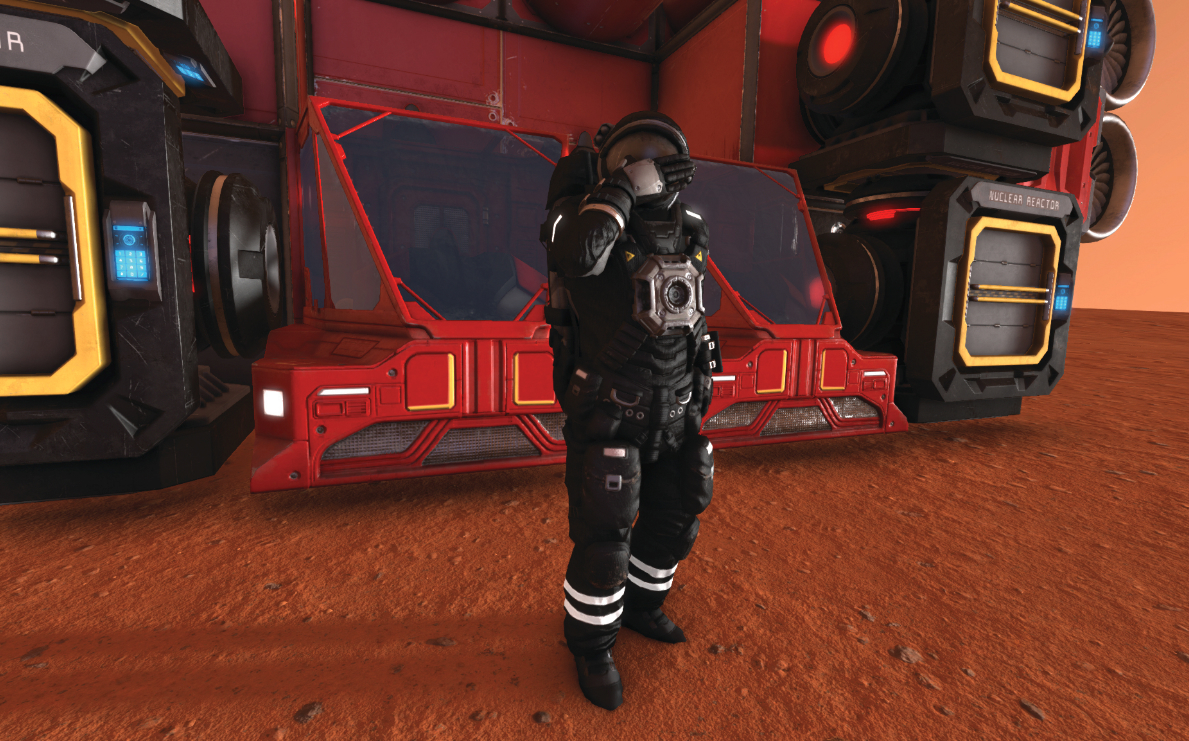
Phil: Sam, I’ve found a thing in the construction menu called a ‘jump drive’. If it works, I reckon we could reach Mars. Either that or it’ll go horribly wrong and we’ll be stranded forever in deep space. Either way, it could be a laugh.
Samuel: Originally, I wanted us to reach the Moon, and even that seemed unlikely to me about 30 minutes ago. But we did it! Fuck it: let’s go to Mars. It’s right over there. How far away can it be?
Phil: I suspect that Space Engineers doesn’t model most of the forces that would prevent our ship from getting off the ground. Plus we’re on the Moon now, and there’s basically no gravity. What I’m saying is let’s just awkwardly bolt the warp drive to the bottom of this ship. We use about six nuclear reactors to power it all, but it seems to work. This is exciting! I punch the warp drive. “Jump drive is only 11.26% charged.” This is going to take a while.
Samuel: Crikey. If the other bits of the ship are space Lego, this is space Duplo. It’s gigantic. This is one ugly-ass vessel, and I’m still sitting on top. Will going into hyperspace not destroy my body?
Phil: We fell to Earth and survived, so you’ll probably be fine. The power charges, I point at Mars and punch that drive. I’m told off by the game for trying to warp into a gravitational body. Why does breaking physics have this many rules? I aim off to the side, and try again. A box appears asking me to confirm the ‘blind jump’. Yes, dammit! Don’t question my orders. Finally, we jump, and arrive... not on orbit around Mars.
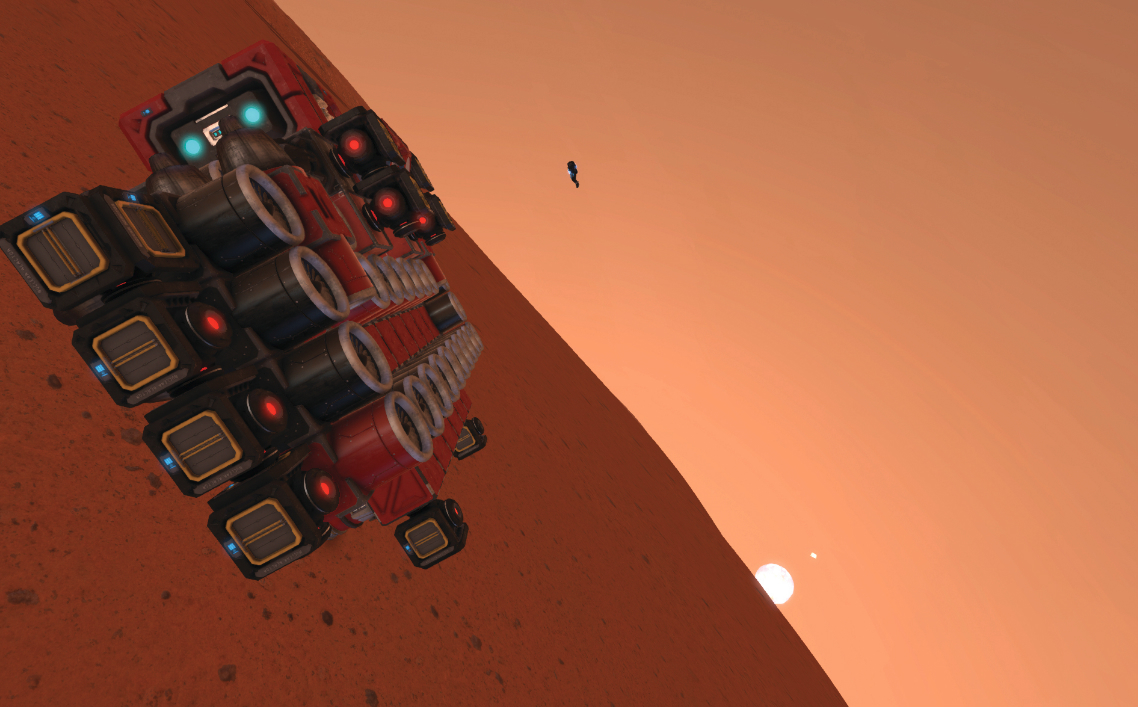
Samuel: I’m alive! Mars is bigger now, but no, we’re not exactly there yet. Going there manually could take forever. Can we jump again to get closer? Phil’s been in the pilot seat for a while now, so I’m basically a passenger, beholden to his expertise.
Phil: We could always swap seats, but this thing still doesn’t have brakes. Anyway, I’ve found the button for decreasing our warp distance. We can’t jump into a planet’s gravitational pull, but I can reduce the distance until we’re at the point closest to its gravity field. After that, it should be a reasonably short trip to the surface. I do, and it is. We’re on Mars!
Samuel: It’s a surprisingly impressive version of Mars, too—the texture of the planet looks very realistic as we enter the atmosphere. We take pictures of each other in front of our crappy-looking, house-shaped spaceship, like rubbish astronauts. I celebrate the freedom of being on Mars by spawning some gigantic wheels in an effort to build a big space car, a surefire sign that I’m procrastinating and that we need to switch the game off and write about our journey to Mars. Kudos, Phil! I feel like I was slightly useless for basically the entire back half of that trip.
Phil: Your moral support was an invaluable contribution, Sam. And so were your screenshots.


